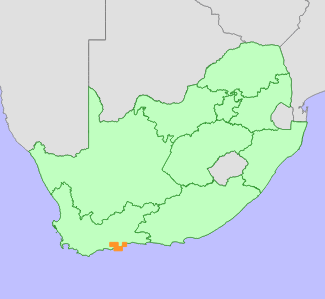|
Scientific Name | Lampranthus diutinus (L.Bolus) N.E.Br. |
Higher Classification | Dicotyledons |
Family | AIZOACEAE |
Synonyms | Mesembryanthemum diutinum L.Bolus |
National Status |
Status and Criteria | Endangered B1ab(ii,iii,iv,v) |
Assessment Date | 2006/10/09 |
Assessor(s) | C. Klak & D. Raimondo |
Justification | EOO 3200 km², five to seven severely fragmented subpopulations are declining due to ongoing habitat loss to coastal development, alien plant invasion and crop cultivation. |
Distribution |
Endemism | South African endemic |
Provincial distribution | Western Cape |
Range | Mossel Bay to Riversdale. |
Habitat and Ecology |
Major system | Terrestrial |
Major habitats | Albertinia Sand Fynbos, Hartenbos Dune Thicket |
Description | Coastal sands. |
Threats |
| Aliens are a moderate threat throughout the range but the threat is concentrated around Albertinia
Agriculture is particularly threatening around Riversdale and Albertinia. Subpopulations from Resiesbaan and Melkhoutfontein are possibly now extinct due to farming.
Coastal Development around Mossel Bay and Still Bay at Rein's Reserve. Rein's Nature reserve has 300 houses proposed for this site - L. multiseriatus grows within an area proposed for development. This is a severe future potential threat as the property is going through the EIA process at the moment (D. Raimondo 2006). |
Population |
Population trend | Decreasing |
Assessment History |
Taxon assessed |
Status and Criteria |
Citation/Red List version | | Lampranthus diutinus (L.Bolus) N.E.Br. | EN B1ab(ii,iii,iv,v) | Raimondo et al. (2009) | |
Bibliography |
Goldblatt, P. and Manning, J.C. 2000. Cape Plants: A conspectus of the Cape Flora of South Africa. Strelitzia 9. National Botanical Institute, Cape Town.
Raimondo, D., von Staden, L., Foden, W., Victor, J.E., Helme, N.A., Turner, R.C., Kamundi, D.A. and Manyama, P.A. 2009. Red List of South African Plants. Strelitzia 25. South African National Biodiversity Institute, Pretoria.
|
Citation |
| Klak, C. & Raimondo, D. 2006. Lampranthus diutinus (L.Bolus) N.E.Br. National Assessment: Red List of South African Plants version 2024.1. Accessed on 2025/12/12 |
 Comment on this assessment
Comment on this assessment


